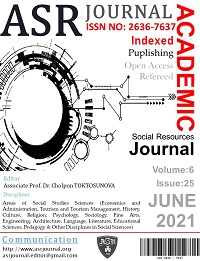Author :
Abstract
Edebi bir metinde mekan, yazarın okuyucuya betimlediği mekanları okuyucunun zihninde canlandırması ile oluşmaktadır. Sinemada mekan ise yönetmenin izleyiciye sunduğu Şekil mekanların kendileri olarak görülmektedir. Farklı aktarım yöntemleri bulunan iki sanat dalında da ortak olan mekan, okuyucu/izleyiciye , Yazar/yönetmen tarafından aktarılmaktadır. Her iki yönteminde karşılaştırmalı yada alanın kendi içinde mekan okumasına dair yapılan akademik çalışma bulunmaktadır. Bu çalışmada 1962 yılında yazılmış, Otomatik Portakal kitabı ve aynı eserin 1971 yılına at sinema yorumu bir arada ele alınacaktır. Bu çalışmada bir distopik dönem hikayesi olan Otomatik Portakal’ın anlatım açısından ait olduğu sanat dalına göre görülen farklılıkları ele alınacaktır. Ayrıca aktarım yapılan eserin, kurguyu ele alan Yönetmen tarafından aktarımda oluşan değişimler incelecektir.
Keywords
Abstract
In a literary text, the place is formed in the reader's mind by the author's visualization of the place described to the reader. But in cinema, place is seen as the visual space that the director presents to the audience. Place which is common in both art branches with different transfer methods is conveyed to the reader / audience by the writer / director. In both methods, there are comperative studies and academic studies on space reading in the field itself. In this study, A Clockwork Orange book written in 1962 and the cinema interpretation of the same work from 1971 will be approached together. In this study, the differences seen in A Clockwork Orange, which is a dystopian period story, according to the branch of art to which it belongs will be discussed. In addition, the changes in the transference will be examined according to the Director who handles the fiction of the work.
Keywords
- Atayman, V. (2019). Şiddetin Mitolojisi (1. Baskı). İstanbul: İthaki Yayınları.
- Atayman, V. (2019). Şiddetin Mitolojisi (1. Baskı). İstanbul: İthaki Yayınları.
- Bachelard, G. (1996). Mekanın Poetikası (1. Baskı). (Çev. Aykut Derman). İstanbul: Kesit Yayınları.
- Burgess, A. (2013). Otomatik Portakal (16. Baskı). (Çev. Dost Körpe). İstanbul: İş Bankası Yayınları. Fiell, P. & Fiell, C. (2013). 1000 Chairs (1. Baskı). Köln: Taschen Publishing.
- Fiell, P. & Fiell, C. (2016). 1000 Lights (1. Baskı). Köln: Taschen Publishing. Göka, Ş. (2001). İnsan Ve Mekan (1. Baskı). İstanbul: Pınar Yayınları.
- Karacaoğlu, E. ‘Mimarlık Aracığılıyla tanrısallık arayışı [2001: Bir Uzay Efsanesi]’, Edebiyatta Mimarlık (Ed. Akarsu, H.T.-Erdoğan, N.) Yem yayınları 2020 istanbul 389-393
- Kubrick, S. (Yönetmen). (1971). A Clockwork Orange [Film]. ABD: Warner.
- Miller, J. (2010). Furniture World Styles From Classical To Contemporary. Londra: DK Publishing.
- Monaco, J. (2000). Bir Film Nasıl Okunur (16. Baskı). (Çev. Ertan Yılmaz). İstanbul: Oğlak Yayınları.
- Narlı, M. (2002). Romanda Zaman Ve Mekan Kavramları. Balıkesir Sosyal Bilimler Dergisi, 5(7), 92-106. Hofsess, J. (1971). Mind’s eye: A Clockwork Orange. Take One Magazine, 3-5
- Houston, P. (1971). Kubrick Country. Saturday Review, 42-44.
- Read, H. (1981). Sanat Ve Toplum (1. Baskı). (Çev. Selçuk Mülayim). Ankara: Umran Yayınları. Siskel, G. (1972). Experts From Rare. Kubirck’le Röportaj. Chicago: Chicago Tribune.
- Stam, R. (2005). Literature Through Film: Realism Magic And Art Of Adaptation. New York: Blackwell Publishing.
- Strick, P.& Houstun, P. (1972). Modern Times. Kubrick’le Röportaj, British: Sight And Sound.
- Şengül, M. (2010). Romanda Mekan Kavramı. 2010 Uluslararası Sosyal Araştırmalar Dergisi, 3(11), 528- 538.
- Yıldız, S. ‘Modern Dünya Kadrajında Bir Oksimoron Otomatik Portakal’, Sinemada Mimarlık, (Ed. Akarsu H. T.- Erdoğan . – Özbursalı T. ) 2020, 2. Baskı Yem Yayınları İstanbul 224-229
- Yüce, T. (2005). Sinema Ve Edebiyat Türleri Arasında Görülen Etkileşimler. ZKÜ Sosyal Bilimler Dergisi, 1(2), 67-74
- Yüksel, E. (2017). Bir Uyarlama Örneği Olarak Yer Altı Filmi. Sinecine Dergisi, 8(1), 39-45
- Zengin, E. (2013). Mekan Kuramı Çerçevesinden Yade Kara’nın Eseri Selam Berlin. Hacettepe Üniversitesi Edebiyat Fakültesi Dergisi, 30(1), 289-298
- Url 1: https://www.hiciste.com/romanda-mekan-unsuru/ ( Erişim Tarihi: 08.09.2020)
- Url 2 : https://www.movie-locations.com/movies/c/Clockwork-Orange.php ( Erişim Tarihi: 08.09.2020) Url 3: https://www.tate.org.uk/art/artworks/jones-chair-t03244( Erişim Tarihi: 08.09.2020)
- Url 4: http://hiddenarchitecture.net/jaffe-house-skybreak-house/ ( Erişim Tarihi: 08.09.2020)Url 5: https://www.rogerdean.com/pods/ ( Erişim Tarihi: 08.09.2020)
- Url 6: http://architectuul.com/architecture/jaffe-house ( Erişim Tarihi: 08.09.2020)
- Url 7:https://lwlies.com/articles/a-clockwork-orange-brutalist-tower-blocks-thamesmead/ ( Erişim Tarihi: 08.09.2020)





